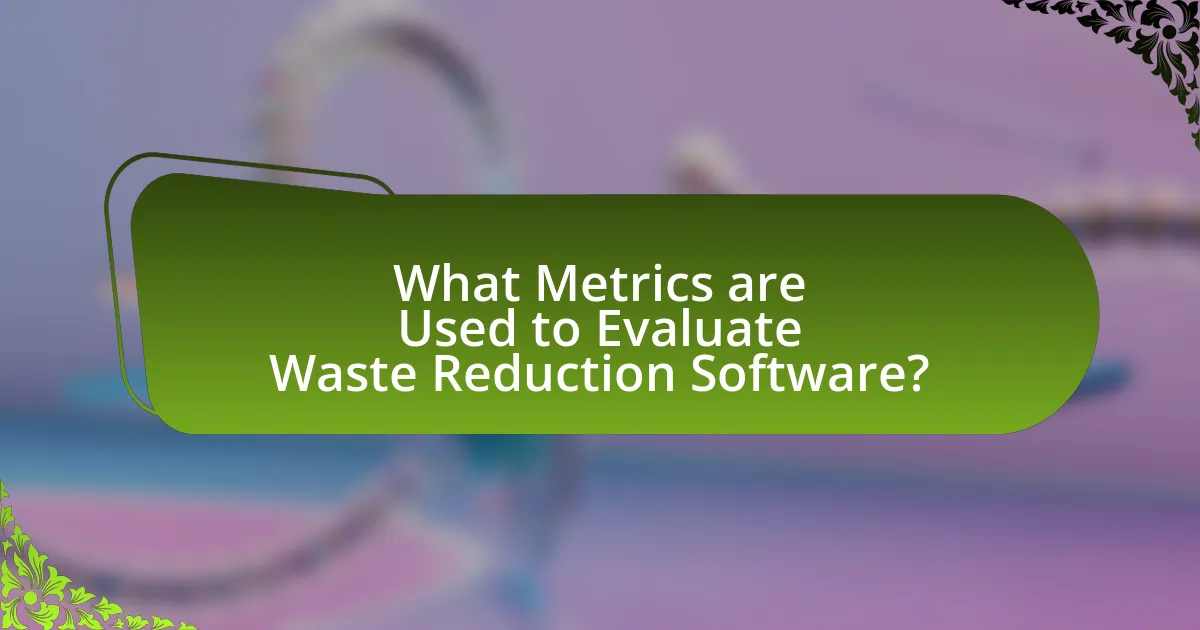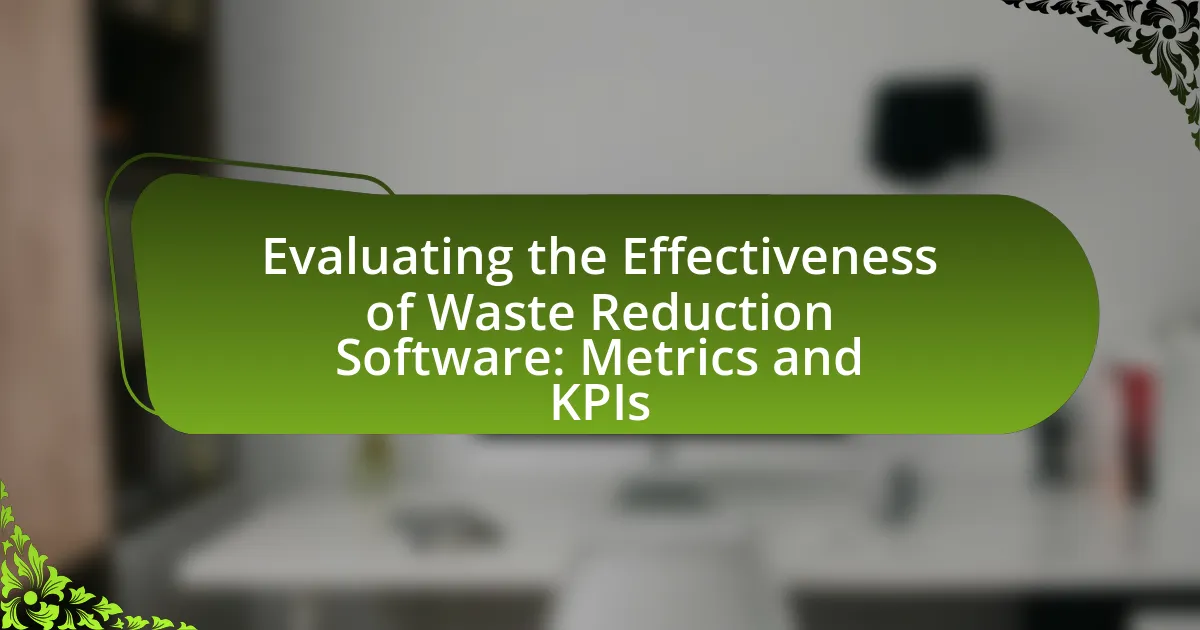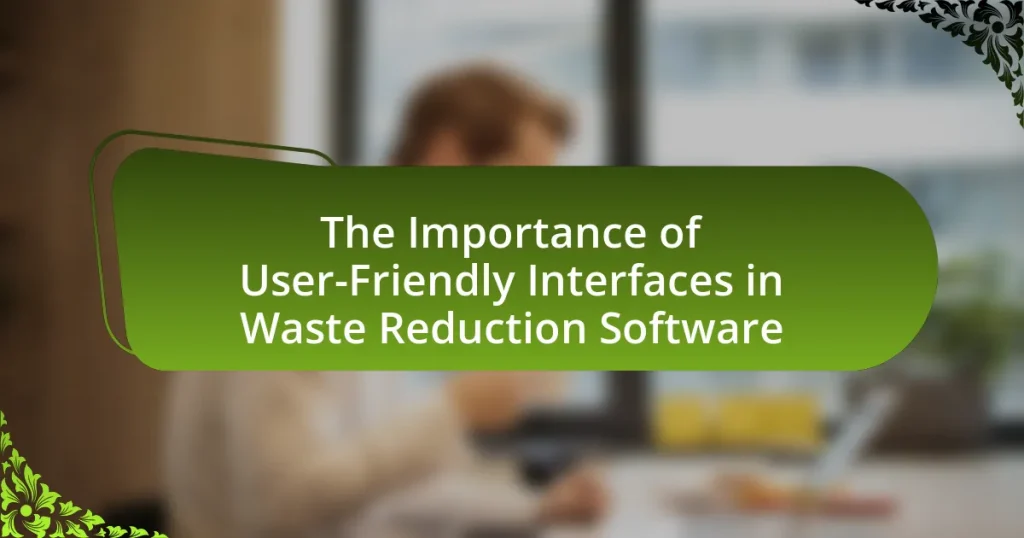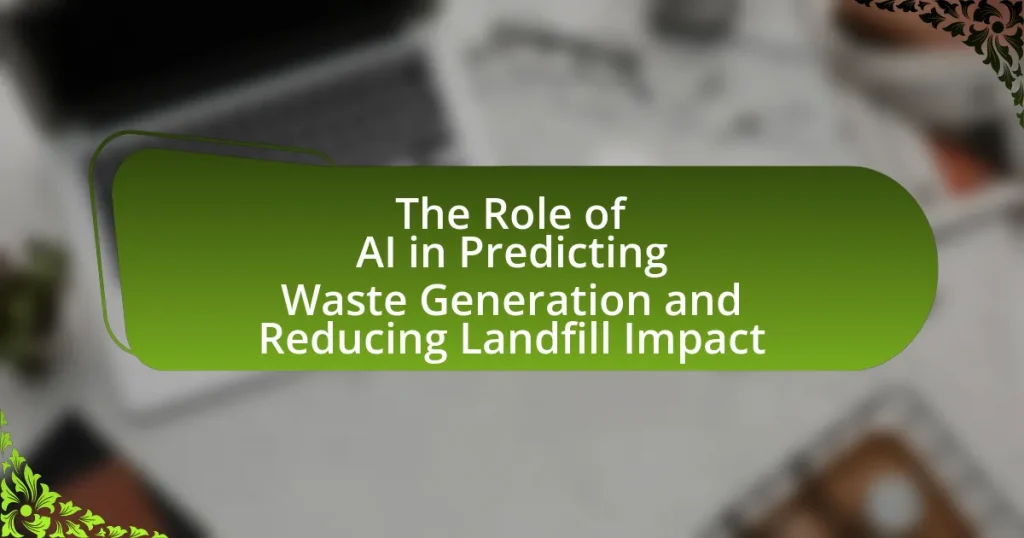Waste reduction software is a digital tool that assists organizations in minimizing waste generation and enhancing resource efficiency. This article evaluates the effectiveness of such software by examining key metrics and performance indicators, including waste diversion rates, cost savings, and user engagement levels. It discusses how waste reduction software functions across various industries, its essential features, and its role in achieving sustainability targets and regulatory compliance. Additionally, the article highlights best practices for implementation and common challenges faced during adoption, providing a comprehensive overview of how organizations can leverage data-driven insights to improve waste management outcomes.

What is Waste Reduction Software and Why is it Important?
Waste reduction software is a digital tool designed to help organizations minimize waste generation and improve resource efficiency. This software is important because it enables businesses to track waste production, analyze data, and implement strategies that lead to reduced environmental impact and cost savings. For instance, a study by the Environmental Protection Agency indicates that effective waste management practices can reduce waste by up to 50%, demonstrating the significant potential of such software in promoting sustainability and operational efficiency.
How does Waste Reduction Software function in various industries?
Waste Reduction Software functions by analyzing data to identify inefficiencies and waste across various industries. In manufacturing, it tracks material usage and production processes to minimize scrap and optimize resource allocation. In the food industry, it monitors inventory levels and expiration dates to reduce food waste, leading to cost savings and improved sustainability. In retail, it assesses packaging and logistics to streamline operations and decrease excess waste. These functionalities are supported by metrics such as waste diversion rates and cost savings, which provide concrete evidence of the software’s effectiveness in reducing waste across sectors.
What are the key features of effective Waste Reduction Software?
Effective Waste Reduction Software typically includes features such as real-time data tracking, analytics and reporting capabilities, user-friendly interfaces, integration with existing systems, and customizable dashboards. Real-time data tracking allows organizations to monitor waste generation and disposal patterns instantly, facilitating timely decision-making. Analytics and reporting capabilities enable users to analyze waste data, identify trends, and generate reports for compliance and improvement purposes. A user-friendly interface ensures that all stakeholders can easily navigate the software, enhancing user adoption. Integration with existing systems, such as inventory management or ERP systems, streamlines operations and data flow. Customizable dashboards provide tailored insights, allowing users to focus on the metrics that matter most to their specific waste reduction goals. These features collectively enhance the software’s effectiveness in achieving waste reduction objectives.
How do these features contribute to waste management goals?
The features of waste reduction software contribute to waste management goals by enhancing data tracking, improving decision-making, and facilitating compliance with regulations. Enhanced data tracking allows organizations to monitor waste generation patterns, leading to targeted reduction strategies. Improved decision-making is achieved through analytics that identify inefficiencies and opportunities for recycling or reuse, which can significantly lower waste volumes. Additionally, compliance features ensure that organizations adhere to local and national waste management regulations, reducing the risk of penalties and promoting sustainable practices. These contributions are essential for achieving overall waste reduction targets and fostering a circular economy.
What are the primary objectives of implementing Waste Reduction Software?
The primary objectives of implementing Waste Reduction Software are to minimize waste generation, enhance resource efficiency, and improve overall sustainability practices within organizations. By utilizing this software, businesses can track waste production, identify reduction opportunities, and streamline waste management processes. For instance, studies have shown that organizations using waste reduction software can achieve up to a 30% decrease in waste output, leading to significant cost savings and environmental benefits.
How does Waste Reduction Software help in achieving sustainability targets?
Waste Reduction Software aids in achieving sustainability targets by providing data-driven insights that optimize waste management processes. This software enables organizations to track waste generation, identify reduction opportunities, and implement strategies that minimize waste output. For instance, a study by the Environmental Protection Agency indicates that businesses utilizing waste reduction software can reduce waste by up to 30%, significantly contributing to sustainability goals. By analyzing metrics such as waste diversion rates and recycling efficiencies, the software helps organizations align their operations with environmental standards and regulatory requirements, thereby enhancing their overall sustainability performance.
What role does Waste Reduction Software play in regulatory compliance?
Waste Reduction Software plays a crucial role in regulatory compliance by helping organizations track, manage, and report waste generation and disposal in accordance with environmental regulations. This software automates data collection and analysis, ensuring that companies meet legal requirements for waste management, such as the Resource Conservation and Recovery Act (RCRA) in the United States, which mandates proper waste handling and reporting. By providing real-time insights and compliance checklists, Waste Reduction Software minimizes the risk of non-compliance penalties and enhances overall environmental performance.

What Metrics are Used to Evaluate Waste Reduction Software?
Metrics used to evaluate waste reduction software include waste diversion rate, cost savings, carbon footprint reduction, and user engagement levels. The waste diversion rate measures the percentage of waste diverted from landfills, indicating the software’s effectiveness in promoting recycling and composting. Cost savings quantify the financial benefits achieved through reduced waste disposal fees and increased recycling revenues. Carbon footprint reduction assesses the environmental impact of waste management practices facilitated by the software, often expressed in metric tons of CO2 equivalent. User engagement levels reflect how actively users interact with the software, which can correlate with successful waste reduction outcomes. These metrics provide a comprehensive framework for assessing the performance and impact of waste reduction software.
How can we measure the effectiveness of Waste Reduction Software?
The effectiveness of Waste Reduction Software can be measured through key performance indicators (KPIs) such as waste diversion rates, cost savings, and user engagement metrics. Waste diversion rates quantify the percentage of waste redirected from landfills, providing a clear measure of the software’s impact on reducing waste. Cost savings can be assessed by comparing expenses before and after implementing the software, highlighting financial benefits. User engagement metrics, including the frequency of software use and user feedback, indicate how effectively the software is being utilized. These metrics collectively provide a comprehensive evaluation of the software’s effectiveness in achieving waste reduction goals.
What are the most common Key Performance Indicators (KPIs) for waste reduction?
The most common Key Performance Indicators (KPIs) for waste reduction include waste diversion rate, total waste generated, recycling rate, and cost savings from waste reduction initiatives. Waste diversion rate measures the percentage of waste diverted from landfills through recycling and composting, providing insight into the effectiveness of waste management strategies. Total waste generated quantifies the overall waste produced, allowing organizations to track progress over time. Recycling rate indicates the proportion of materials recycled compared to total waste, reflecting the efficiency of recycling programs. Cost savings from waste reduction initiatives highlight the financial benefits achieved through reduced waste disposal costs and improved resource efficiency. These KPIs are essential for evaluating the effectiveness of waste reduction efforts and guiding future strategies.
How do these KPIs reflect the software’s performance?
KPIs reflect the software’s performance by quantifying its efficiency, effectiveness, and impact on waste reduction. For instance, metrics such as waste diversion rate and cost savings directly indicate how well the software optimizes waste management processes. A higher waste diversion rate signifies that the software successfully facilitates recycling and composting, while significant cost savings demonstrate its ability to reduce operational expenses. These metrics provide concrete evidence of the software’s contribution to sustainability goals and operational efficiency, validating its effectiveness in real-world applications.
What qualitative metrics should be considered in evaluation?
Qualitative metrics that should be considered in the evaluation of waste reduction software include user satisfaction, stakeholder engagement, and behavioral change. User satisfaction can be assessed through surveys and interviews, providing insights into how effectively the software meets user needs and expectations. Stakeholder engagement metrics evaluate the involvement and feedback from all parties affected by the software, ensuring that diverse perspectives are considered in the evaluation process. Behavioral change metrics focus on the extent to which the software influences users’ waste management practices, which can be observed through case studies or qualitative assessments. These metrics are essential for understanding the software’s impact beyond numerical data, providing a comprehensive view of its effectiveness.
How can user satisfaction be quantified in the context of Waste Reduction Software?
User satisfaction in the context of Waste Reduction Software can be quantified through metrics such as user engagement scores, Net Promoter Score (NPS), and user feedback surveys. User engagement scores measure how frequently and effectively users interact with the software, indicating their satisfaction level. The Net Promoter Score assesses the likelihood of users recommending the software to others, providing a clear metric of user satisfaction. Additionally, user feedback surveys can collect qualitative and quantitative data on user experiences, preferences, and pain points, allowing for a comprehensive evaluation of satisfaction levels. These methods are supported by industry practices that emphasize the importance of user-centric metrics in software evaluation, ensuring that user satisfaction is effectively measured and addressed.
What feedback mechanisms are effective for assessing software usability?
Effective feedback mechanisms for assessing software usability include user testing, surveys, and analytics. User testing allows real users to interact with the software, providing direct insights into usability issues. Surveys can gather quantitative and qualitative data from users about their experiences, preferences, and pain points. Analytics tools track user behavior, revealing patterns in how the software is used, which can highlight areas needing improvement. Research indicates that combining these methods enhances the overall understanding of usability, as each mechanism provides unique insights that contribute to a comprehensive evaluation.

How to Analyze the Data Collected from Waste Reduction Software?
To analyze the data collected from waste reduction software, first, categorize the data into relevant metrics such as waste volume, recycling rates, and cost savings. This categorization allows for a structured evaluation of performance against predefined Key Performance Indicators (KPIs). Next, utilize statistical methods to identify trends and patterns over time, which can reveal the effectiveness of waste reduction initiatives. For instance, comparing waste generation before and after implementing the software can provide insights into its impact. Additionally, visualizing the data through graphs and dashboards can enhance understanding and facilitate communication of findings to stakeholders. This approach is supported by studies indicating that data visualization improves decision-making in waste management contexts.
What analytical methods can be applied to waste reduction data?
Statistical analysis, regression analysis, and data visualization are key analytical methods that can be applied to waste reduction data. Statistical analysis helps identify trends and patterns in waste generation, allowing organizations to quantify reductions over time. Regression analysis can model the relationship between waste reduction initiatives and actual waste output, providing insights into the effectiveness of specific strategies. Data visualization techniques, such as charts and graphs, facilitate the interpretation of complex data sets, making it easier to communicate findings and drive decision-making. These methods collectively enhance the understanding of waste reduction efforts and support continuous improvement initiatives.
How can data visualization enhance understanding of waste metrics?
Data visualization enhances understanding of waste metrics by transforming complex data into intuitive graphical representations, making it easier to identify trends and patterns. For instance, visual tools like charts and graphs can illustrate waste generation over time, allowing stakeholders to quickly grasp fluctuations and correlations. Research indicates that visual data can improve retention and comprehension by up to 400% compared to text-based information, as shown in studies by the University of Minnesota. This clarity enables organizations to make informed decisions regarding waste reduction strategies, ultimately leading to more effective waste management practices.
What statistical tools are useful for interpreting waste reduction results?
Statistical tools useful for interpreting waste reduction results include regression analysis, ANOVA (Analysis of Variance), and control charts. Regression analysis helps identify relationships between waste reduction efforts and outcomes, allowing for predictions based on historical data. ANOVA is effective for comparing means across multiple groups, which can reveal significant differences in waste reduction performance among various strategies or time periods. Control charts monitor waste reduction processes over time, helping to identify trends and variations that may indicate the effectiveness of implemented measures. These tools provide a robust framework for analyzing data and drawing actionable insights in waste management contexts.
How can organizations use insights from data analysis to improve waste management?
Organizations can use insights from data analysis to improve waste management by identifying patterns in waste generation and optimizing resource allocation. For instance, data analytics can reveal peak waste production times, enabling organizations to adjust collection schedules and reduce overflow. Additionally, analyzing waste composition data helps organizations target specific materials for recycling or reduction, leading to more effective waste diversion strategies. A study by the Environmental Protection Agency found that organizations implementing data-driven waste management practices reduced waste by up to 30%, demonstrating the tangible benefits of leveraging data insights for improved waste management outcomes.
What strategies can be implemented based on data-driven insights?
Data-driven insights can lead to several effective strategies for waste reduction software, including targeted resource allocation, predictive analytics for waste generation, and continuous performance monitoring. Targeted resource allocation allows organizations to focus efforts on areas with the highest waste output, as evidenced by data showing that 70% of waste often comes from 30% of processes. Predictive analytics can forecast future waste trends based on historical data, enabling proactive measures; studies indicate that companies using predictive analytics can reduce waste by up to 25%. Continuous performance monitoring ensures that waste reduction initiatives are assessed in real-time, allowing for timely adjustments and improvements, which is supported by research indicating that organizations with real-time data access improve operational efficiency by 15%.
How can continuous improvement be achieved through data analysis?
Continuous improvement can be achieved through data analysis by systematically collecting, analyzing, and interpreting performance metrics to identify areas for enhancement. For instance, organizations can utilize key performance indicators (KPIs) related to waste reduction, such as the volume of waste generated per unit of production, to pinpoint inefficiencies. By applying statistical methods, such as regression analysis, organizations can uncover trends and correlations that inform decision-making. Research indicates that companies employing data-driven strategies can improve operational efficiency by up to 15%, as evidenced by a study published in the Journal of Operations Management, which highlights the positive impact of data analytics on process optimization.
What are the best practices for implementing Waste Reduction Software effectively?
The best practices for implementing Waste Reduction Software effectively include conducting a thorough needs assessment, ensuring stakeholder engagement, providing comprehensive training, and establishing clear metrics for evaluation. Conducting a needs assessment helps identify specific waste reduction goals and software requirements, ensuring alignment with organizational objectives. Engaging stakeholders, including employees and management, fosters buy-in and facilitates smoother adoption. Comprehensive training equips users with the necessary skills to utilize the software effectively, which is crucial for maximizing its potential. Establishing clear metrics, such as waste diversion rates and cost savings, allows organizations to evaluate the software’s impact and make data-driven adjustments. These practices are supported by research indicating that organizations with structured implementation strategies experience higher success rates in waste reduction initiatives.
How can organizations ensure successful adoption of Waste Reduction Software?
Organizations can ensure successful adoption of Waste Reduction Software by implementing comprehensive training programs and fostering a culture of sustainability. Effective training equips employees with the necessary skills to utilize the software efficiently, which is crucial for maximizing its benefits. A study by the Environmental Protection Agency indicates that organizations with structured training programs see a 30% increase in software utilization rates. Additionally, promoting a culture of sustainability encourages employee engagement and commitment to waste reduction goals, leading to higher adoption rates. Research from the Journal of Cleaner Production shows that organizations that integrate sustainability into their core values experience a 25% improvement in software adoption success.
What common challenges should be anticipated during implementation?
Common challenges anticipated during the implementation of waste reduction software include resistance to change, data integration issues, and user training difficulties. Resistance to change often arises from employees who are accustomed to existing processes and may be hesitant to adopt new technologies. Data integration issues can occur when the software needs to interface with existing systems, leading to potential compatibility problems. User training difficulties may stem from the complexity of the software, requiring significant time and resources to ensure that all users are proficient. These challenges are well-documented in case studies, such as the implementation of waste management systems in various municipalities, which highlight the importance of addressing these issues proactively to ensure successful adoption and effectiveness.



